Or, what are Meklon's monsters good for?
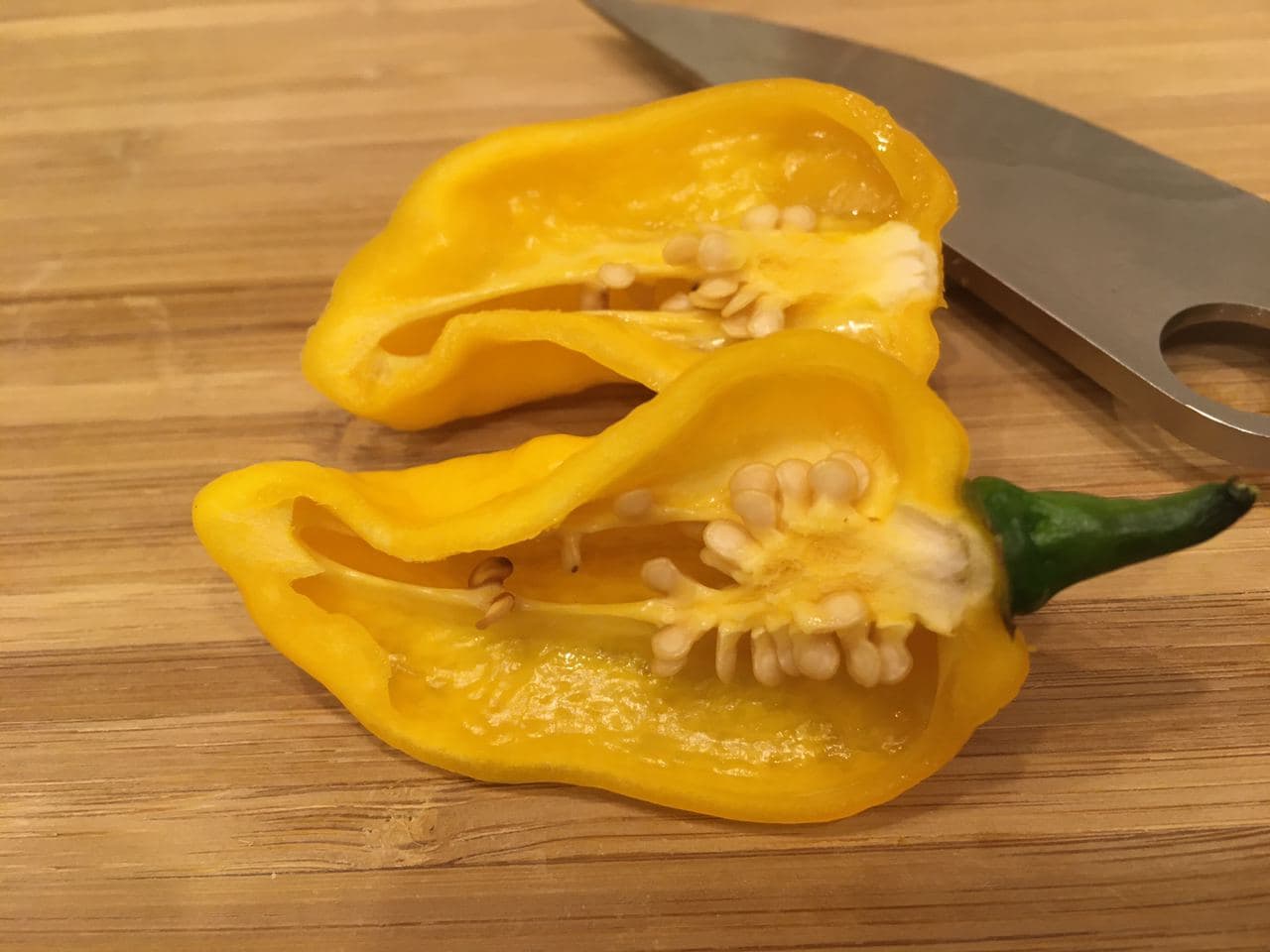
I am writing this post based on the Hydroponics engineering manual . Growing super hot chili and making everyone eat it . It so happened that I am one of those whom Meklon considered it his duty to "feed and see what happens to them . " I, in turn, consider it my duty to tell about this inhuman experiment, in my opinion, the article pays too little attention to the pepper itself. And he deserves more!
In addition, I am absolutely sure of this, after his article a lot of neophyte hydroponicists should appear, because the topic is no less interesting than profiteroles, which means that in a few months, in different parts of the world where Habr is read, a certain the amount of extremely hot peppers with which you will have to do something. The problem is that one average family cannot consume the entire Scorpion Trinidad crop on their own. This means that peppers will be intensively shared, but not everyone will understand why such an exotic fruit can be useful and what to do with it.
About this - and will be my story, how to cook something edible from hellish peppers and not suffer much in the process.
As I saw these peppers and googled the topic, I immediately got the idea to use them somehow! I love spicy and I tolerate it well, I eat Asian cuisine in the "spicy" option without any problems, and therefore, the number of "million scoville" fascinated me. Despite my love for spicy food, I was not particularly interested in all these subtleties and culinary details, and only learned about scovillies in detail after Meklon's article.
Because of all the Covid that got me, my summer turned out to be relatively free and I had the opportunity to visit Krasnodar, combining business with pleasure: dental tourism, motorcycle travel and the opportunity to see people with whom I have made friends online for a long time. As a result of the trip, one and a half Scorpions of Trinidadik left for Moscow.

The first experience was pretty straightforward. One and a half peppers pounded into a paste were mixed with a hot sauce - making a very hot sauce out of it. It turned out something from the category of "three drops per herd", but it was eaten after a couple of months. I wanted more ... And then, after a long wait, THEY arrived:

Of course, this is not all for me alone - I worked as a staging post for distributing peppers, which was organized in a colorful Moscow burger.
Party of Crazy Peppers is a success! About a dozen people came, the people recklessly tasted the peppers in cash and in burgers, shared their impressions, and one seasoned pepper even brought spicy sauces of its own preparation. A package of disposable gloves and small bags for peppers was prudently seized; someone even brought cream to "treat" those who had overeating spicy food. There were some incidents, one comrade wiped sweat from his face with pepper gloves and then shared vivid impressions of this act, and his girlfriend, having tasted a piece of pepper, drank several glasses of various liquids that were within reach. The parcel sold out with a bang!

I will try to describe my feelings from this amazing fruit.
Pepper is completely unusual. It doesn't look like anything at all. At first, attention is drawn to itself - a very, very strong smell, thick and bright fruity aroma, a mixture of mango, peach, pineapple and something else incomprehensible. The smell is surprisingly strong and very pleasant, at a Moscow party of "crazy peppers" girls for ten minutes could not tear themselves away from a bag of peppers and blissfully inhaled their aroma.

When rubbing peppers for sauce - the smell filled the whole apartment: “This is completely abnormal! It smells stronger than flowers and fruits! " ... This is the scent that makes Trinidad Scorpion CARDI stand out.(Caribbean Agricultural Research and Development Institute) from other peppers of the Scorpion variety and the usual type of Chile, Bulgarian or Jalapeno, these are nothing at all, they smell like ordinary vegetables.
Chewing on a small piece of pepper - for the first moment you feel a strong and rather sweet fruity taste. But only in the first and very short moment ... Because it is followed by a growing burning sensation, turning into a wave of hellish heat and pains that fill your mouth as if you took boiling water there, but you cannot spit it out. The fire burns the whole mouth, to the most distant corners. If you overdo it, then sweat appears on the forehead, as after a bath, the face and eyes turn red, the nose instantly begins to run out with snot, and the eyes - tears. The main thing is to try not to hurt your lips during tasting, for some reason they hurt more than the mucous membrane. And at first you shouldn't take deep breaths, otherwise you won't just cough - your breath naturally catches!
— !
, , — . , , .
If you forget and break this rule, the result will be very cruel. The skin of the face, the nasal mucosa and especially the eyes will burn intolerably with fire. Since the concentration of capsaicin in Scorpio is very high, this is one of the most acute varieties in the world - the burning sensation will be very strong, but it will not go away immediately. Depending on the intensity, it can hurt for up to an hour or more! Even a small amount of juice that gets on furniture or tableware will deliver an unpleasant surprise to anyone who touches it.
Capsaicin in high concentration is not washed off with water, because it does not dissolve in it at all. Despite the fact that it is theoretically soluble in fats and alcohols, in practice, neither oil nor alcohol can wash it off the skin, except that cold and rich milk temporarily relieves pain. So - you just have to endure ... One friend told me how he decided to do without gloves when working with Scorpio, then he scratched his nose with his hands stained with pepper, and then his wife decided to console him and kissed him on his sore nose ... Both had bright impressions. Like in the video:
In order to understand the seriousness of this warning - find videos on YouTube with the words "pepper spray in your face" and look carefully. Because the result will be very similar. Capsaicin is extracted from the peppers of this variety on an industrial scale, and on plantations people collect it in suits resembling OZK.
A bit of theory
He told me his feelings, frightened them with warnings - now let's try to figure out why these peppers are so hot, and at the same time blow up several myths on the topic of severity.
The pungency of pepper is one of many diverse plant defense mechanisms. Since they cannot move or otherwise actively respond to unpleasant (or pleasant) influences, the plants were forced to develop a variety of passive methods of protection or attracting attention. The flowers give off strong aromas and sweet nectar that summons pollinators. The seeds of some plants are equipped with hooks in order to cling to animals and expand their distribution. The fragile shoots of bushes are protected with thorns so that animals do not trample them. Nettle leaves are equipped with stinging cells, which contain a compound of complex composition, including formic acid, which has a strong irritating effect. Poison ivy juice contains a complex of toxins called " Urushiol "that cause a strong allergic reaction.
Pepper is protected by a very interesting substance - capsaicin . Its difference from other herbal poisons is that, contrary to popular belief, the burning sensation from hot pepper has nothing to do with the destructive effect. The capsaicin contained in pepper is not caustic, does not cause allergies, does not affect the cells of animal tissues, does not ... In short, it does not cause any physical or chemical damage, in general, absolutely and absolutely.
By the type of influence, it can be compared with a game cheat, which, instead of complex manipulations and wandering through the levels, allows you to get a bun by typing a certain combination on the keyboard. Another example: when, instead of cunning actions with the buttons of an electronic lock, or physical hacking with a grinder, you connect directly to the contacts of the unlocking electromagnet.
Capsaicin works in the same way, bypassing all the coarse and destructive mechanisms of a low level, it, with a cleverly twisted master key, directly turns on vanilloid receptors (TRPV1, transient receptor potential vanilloid), one of the functions of which is to transmit a sensation of warmth to the brain. It does not cause heating, cells do not burst from extreme heat, the skin or mucous membrane does not flake off as in a severe burn, does not char. Absolutely nothing happens to her - nothing. But the receptors located in it signal: "Very high temperature!" And the brain reacts accordingly. As in the Matrix, there is no heating itself - but the brain receives information about the hellfire around.

And having received such a signal, the body turns on defense mechanisms: capillaries expand in the skin and blood rushes to the place of the "burn"; the eyes react with profuse lacrimation; inhaling droplets of juice - a person can cough, and so on. A person feels pain, sometimes very strong, but physically does not receive the slightest harm.
Yes, it is very painful, the skin turns red, the eyes are watering, snot to the floor, I want to smash my head on the sink - but all the sensations will pass without a trace or harm (except for a broken head). The more concentration, the stronger the manifestations and the longer they last, but cases of severe health problems caused by capsaicin can literally be counted on one hand.
Perfect pain in its purest form.
Another common misconception is that pepper, because of its pungency, kills all bacteria and ensures the safety of foods in hot climates. Alas, this is not so. The microorganisms causing rotting do not have vanilloid receptors and they do not particularly react to capsaicin. Hot peppers spoil like any other.
Another interesting fact is that capsaicin does not cause any noticeable reaction in all animals, mammals react to it most of all, and birds do not notice at all. Apparently because the avian digestive tract handles seeds more delicately and promotes better plant propagation ( ornithochoria), in contrast to the millstones of goat teeth, stomach with several sections and enzymes sharpened to digest plant foods and destroy everything that gets inside. And if capsaicin physically burned like acid, birds would be just as bad as mammals.
How to understand how hot this or that variety of pepper is and what to expect from it? Will there be a "nuclear burn" in your mouth or just "warm tea"? For this, at the beginning of the last century, the American pharmacist Wilbur Scoville invented an organoleptic scale of pungency. He made an alcoholic infusion of the specified grade and diluted it with water until the burning taste ceased to be felt. The scale is rather arbitrary and not very accurate, but such was the amateur chemistry a hundred years ago. Modern researchers determine the pungency using chromatography, considering that capsaicin is not the only pungent substance found in peppers.
But with all the shortcomings, this method has become popular and is still used, and the unit of sharpness was named after the author of the method - " scoville ".

On the sign, you can estimate where the Scorpion Trinidad is located (800,000 -1,200,000 scoville). I'll say right away - quite high. There are several more record varieties, and even higher is only pure chemistry. So, keep in mind, despite its pleasant smell - the pepper is rather gloomy.
What can you do with such a pepper? Of course the sauce!
Moreover, it is absolutely not necessary to achieve the maximum amount of hot pepper in the composition, first it is better to make a "light version", with a capsaicin concentration of no more than 200k scoville. Is it a lot or a little? After all, the spiciness of the well-known jalapenos is from 2k to 8k scoville, and the sauce is 10-100 times spicy! In fact, it is normal. Nobody eats such a sauce in its pure form, it is added to the finished dish, therefore, such a sharpness is enough.
I add about ¼-½ teaspoon to a bowl of soup or meat with a side dish, it turns out quite spicy, but without the tin. The pungency does not linger in the mouth for a long time and does not spoil the taste of the dish. But, you have to stir it very well in the seasoning dish. A full teaspoon can ruin all the pleasure, this sauce does not forgive careless handling.
Pepper lovers consider this sauce weak. But if someone is not even accustomed to such spiciness, then you can dilute the sauce with ketchup or tomato paste. 150-200k scovilli allows you to make it spicy - any other sauce and the degree of pungency are easy to regulate, in contrast to high concentration formulations, from which an unprepared person can have such a fire - that will discourage all the desire for such experiments.
So let's get started.
You need to start with the equipment of the workplace:
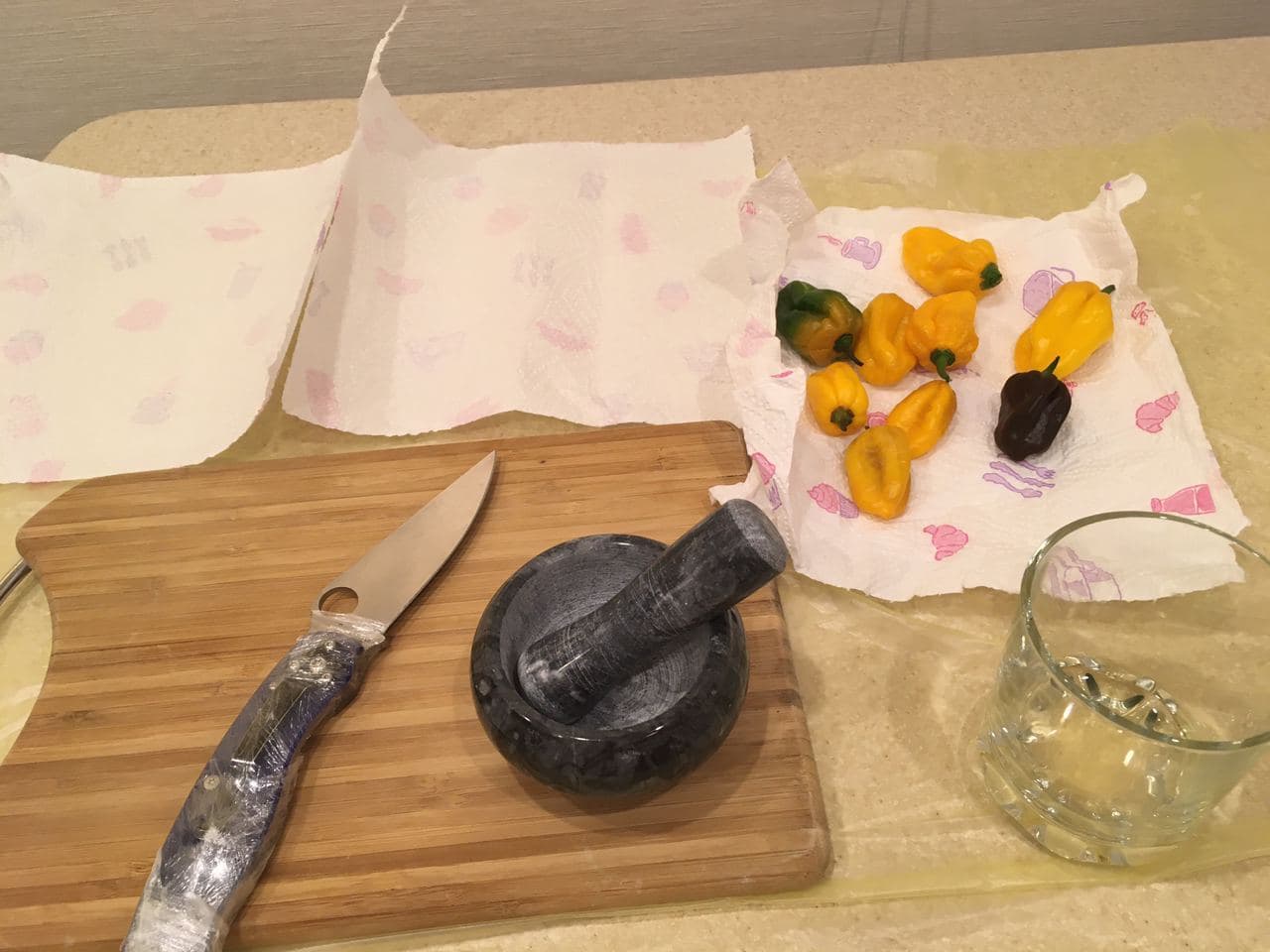
To work with pepper, you need to select a separate dish, which will then need to be soaked in liquid for washing overnight - otherwise it will not be washed off.
After the first experiment with peppers, I thoroughly washed the knife, spoon and mortar, as usual - with a brush and faerie. Well done! And then he licked the blade of the knife and ... I got burned! It turned out that at this concentration, the capsaicin is not washed off the first time. Remember this so that no one touches this dish with their hands or tries to cut the bread on the pepper board. Pets may not appreciate the burning sensation of capsaicin! Separate knife, separate spoon, separate plank, separate plates. Cover the table with a disposable plastic tablecloth or something similar. Set all the ingredients in advance so as not to climb around the cabinets and the refrigerator once again, because for this you will have to take off your gloves and then put on new ones again. Do not touch furniture, dishes, people and pets with pepper gloves - they will not be happy about it! About,that you shouldn't touch your face - I have already warned. Place a separate napkin under the seeds with films that you will extract from the peppers, on which you will then dry them (if you suddenly want to grow more or share with friends).
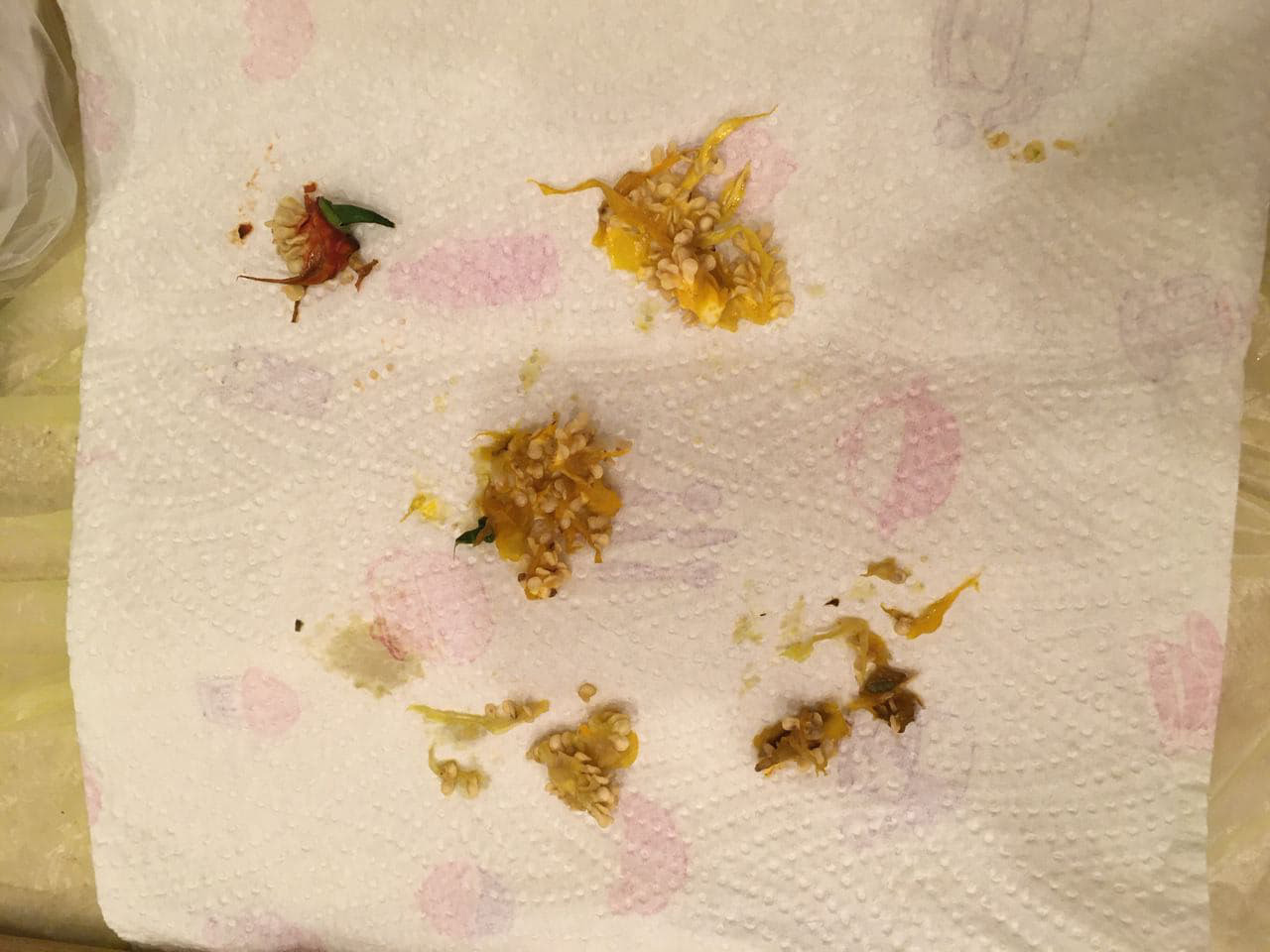
There is a separate warning regarding gloves.
As it turned out, simple plastic gloves are not suitable for working with such pepper, mine burned through and I regretted it. The palms burned for several hours as if I constantly kept them in boiling water. When I took off my gloves, I licked my finger and felt a burning sensation, which means that my hands could get dirty and cause trouble for my family. Therefore, then I had to continue to do everything else with gloves, so as not to grab the stove and everything around with my peppery hands. The sensations were not pleasant, but the strategy turned out to be correct, no one else reproached me in the spirit: “Because of you, my nose and fingers burn again, but I just touched the cupboard!”, As it was after the first experience.
In the morning everything went away, as it seemed to me, but when I began to brush my teeth, it seemed as if I was holding in my hands not a harmless plastic brush, but a poker from a fire.
According to experienced perceivers - latex ones also do not save. Next time, I'll take thick household ones for this.
The first step is to thoroughly grind the peppers:
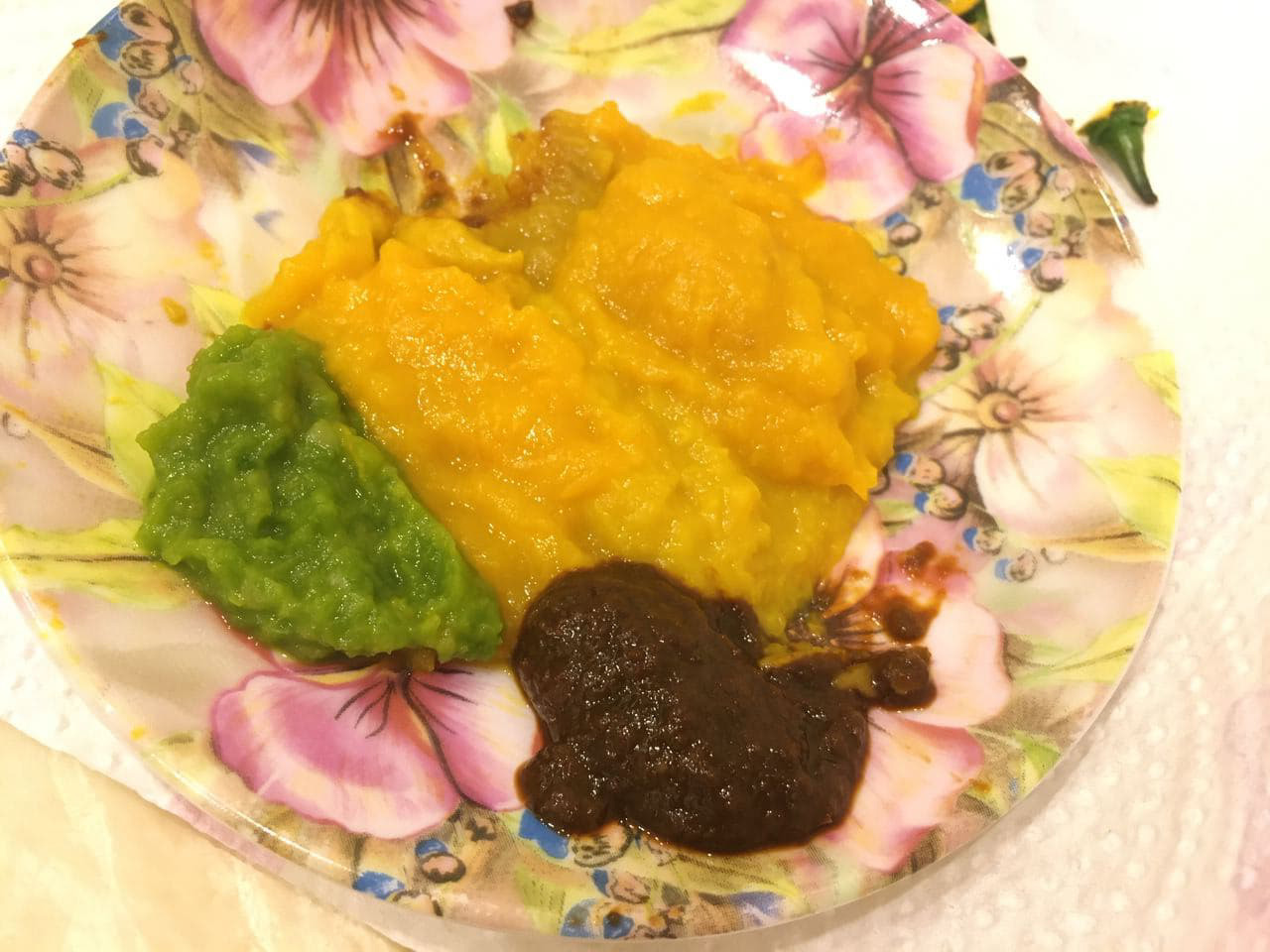
Yellow - ripe scorpions, green - one unripe Scorpio, brown - Habanero Chocolate.
And here was my second mistake - the wrong mortar.
It seemed to me that to grind small peppers - you need the smallest. Alas, the pistil was sosmall, that the fingers were too close to the pepper, it was uncomfortable to hold the pestle and had to squeeze it with all my might. This led to the fact that the gloves were heavily soiled in the juice and it penetrated the polyethylene. The mortar may not be very large, because the peppers are really small, but the handle should be long so that your hands are away from the pepper, and it is comfortable to hold on to it.
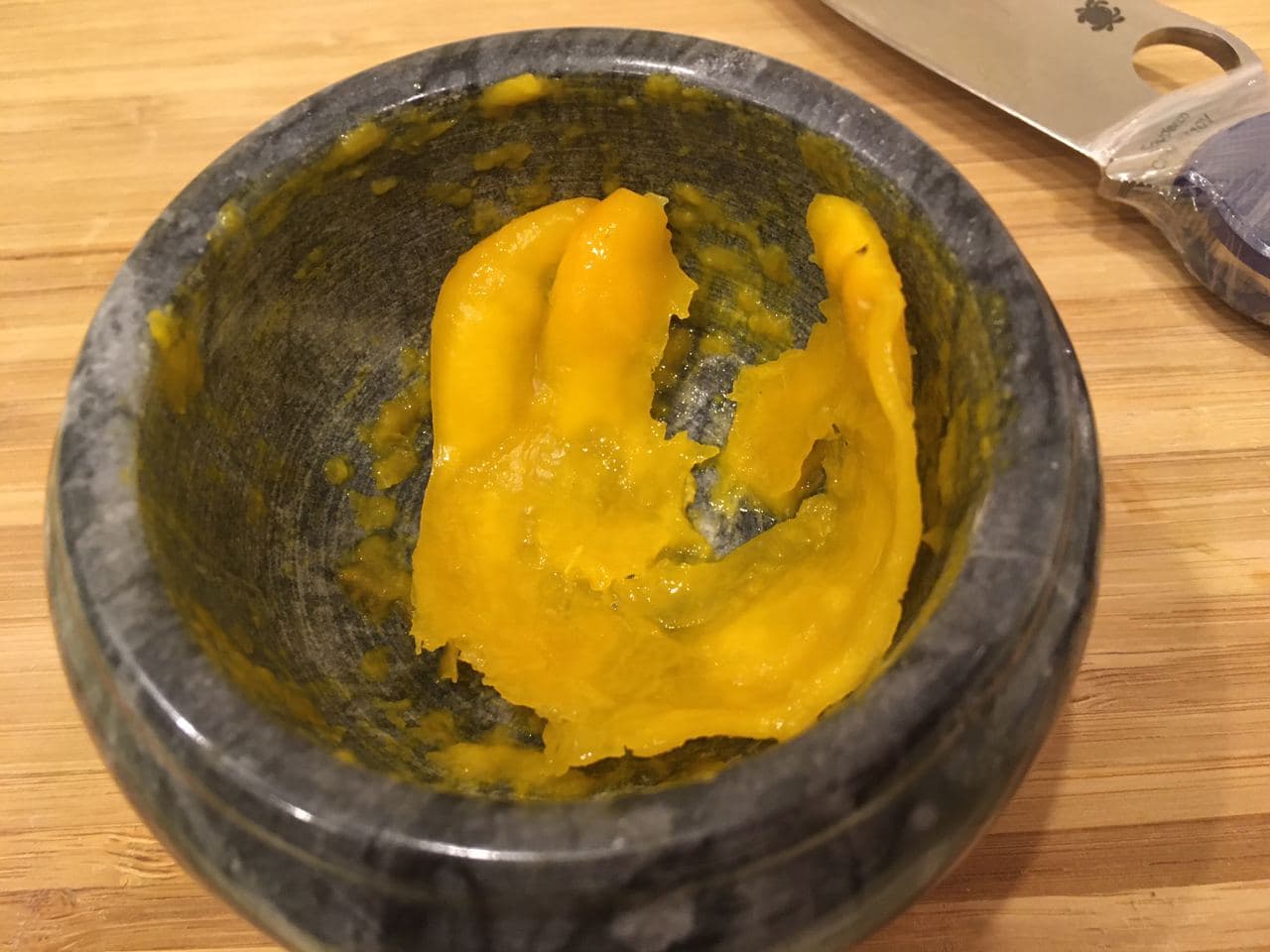
Why did I grind peppers at all? I explain.
The concentration of capsaicin in fruits is very high, if you grind them with a blender, then the resulting puree will inevitably contain small pieces of pulp and rind. If such a piece gets on the mucous membrane, it will locally increase the concentration of capsaicin and it will feel like a small burn. This is not to say that it is very unpleasant, but if you grind the peppers into a homogeneous paste, then the pulp will completely and evenly dissolve in the base of the sauce and the pungency will be evenly distributed. It is necessary to rub until the peel of the pepper is completely rubbed into a homogeneous puree along with the pulp, there should be no separate pieces of the peel. But the point is that I do not like dense pieces of peel and hard seeds in such sauces or stews, but these are more my personal troubles.

The peppers are pounded, stacked on a platter and covered with a lid or bag, out of harm's way - it's time to start preparing the base. It was the first homemade sauce and was recommended to use the usual tomato base. It is difficult to spoil it and it is universally suitable for any peppers and dishes.
This will require:
- Tomatoes. I bought a 400 gram can;
- Bell pepper. Gram 200, approximately;
- Worcester sauce. You will need 2-3 heaped tablespoons;
- Apple vinegar. 40 ml for this amount of products for the base;
- Alcohol. Also 40 ml;
- Herbal spices. I had turmeric and hops-suneli, you can add a ready-made mixture of French or Italian herbs - whoever likes what;
- Sugar. About 1-1.5 teaspoon. You can use baby applesauce or concentrated apple juice instead of sugar.
- Salt is not needed .

The tomatoes were recommended to buy peeled in a jar, but I didn't really like it because they were with liquid and seeds. I don't really like all this in such products (as I said, that's why I ground the peppers into a paste). It is better to buy fresh and fragrant tomatoes on the market, then peel them off, open and peel them yourself. It is also better to remove the liquid from the cavities with the seeds - less time will be spent on evaporation. The peel from the tomatoes is easy to remove, it is enough to lower them in boiling water for 15-45 seconds and then it comes off without any difficulty.
You can buy Bulgarian pepper, but not necessarily, any sweet variety will do. I didn't find enough fresh bell peppers, so I bought Ramiro. It would be good to clean it too. To do this, you need to cut the pepper into quarters (it was more convenient for me to gut the seeds and the stalk from the raw fruit than to try to pick out the seeds from the hot pepper later), put on a baking sheet covered with parchment and put in the oven for 15-20 minutes at a temperature of 100-120 degrees. Then you need to put them on a plate and cover with polyethylene for 15 minutes. After this execution, the peppers become soft, and the skin is easily removed.

Worcester sauce was recommended to me of this particular brand, but maybe someone prefers a different one. It is better to find apple cider vinegar at a higher price, completely deshman vinegar can smell unpleasant.
Alcohol is chosen according to taste and personal preferences, it can be a good aromatic whiskey or cognac, liqueur, tincture - according to personal preferences. One friend who has a lot of respect for Scottish single malt called me a dude when she saw what I was transferring this valuable liquid to.
Buy the amount of tomatoes and sweet peppers based on the available amount of hot peppers and the desired pungency. After all the boils, I got about 400 grams of ready-made sauce, including 55 grams of hot pepper paste. That is, about 200 grams of liquid lost the original products, and the ratio of base to pepper was 1 to 7. One-seventh of a million scoville is the approximate pungency of the sauce in these conventional units.
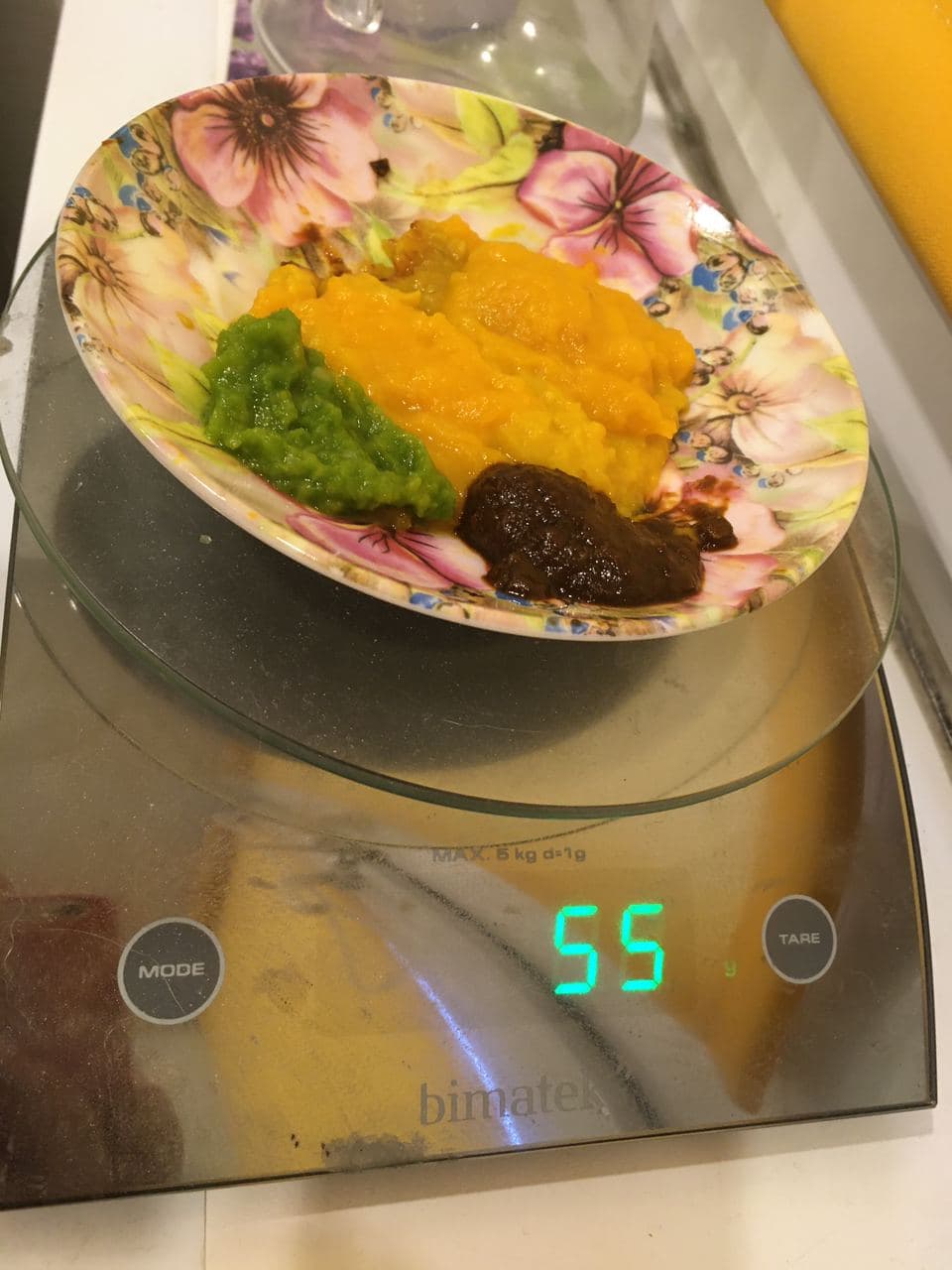
After grinding the pepper, you can remove the overalls and carry out the rest of the steps as usual. First, I recommend peeling the bell peppers so that they start stewing at the same time as the tomatoes, which can be peeled while the peppers are simmering in the oven. Then cut the sweet peppers and tomatoes into small pieces and begin to evaporate in a small saucepan, stirring constantly, until you get a gruel with a thickness like tomato paste or ketchup. Or a little more liquid. The main thing is not to let it burn, the fire should be less than average and you should not be lazy to stir the brew. This can take from 20 to 40 minutes. In fact, it turns out stewed bell peppers in tomatoes.
About halfway through the base, add Worcestershire sauce.
Along with the sauce, I added three crushed young garlic cloves. Just because I like garlic, and during the evaporation the pungent smell almost disappeared.
Again a question of taste.
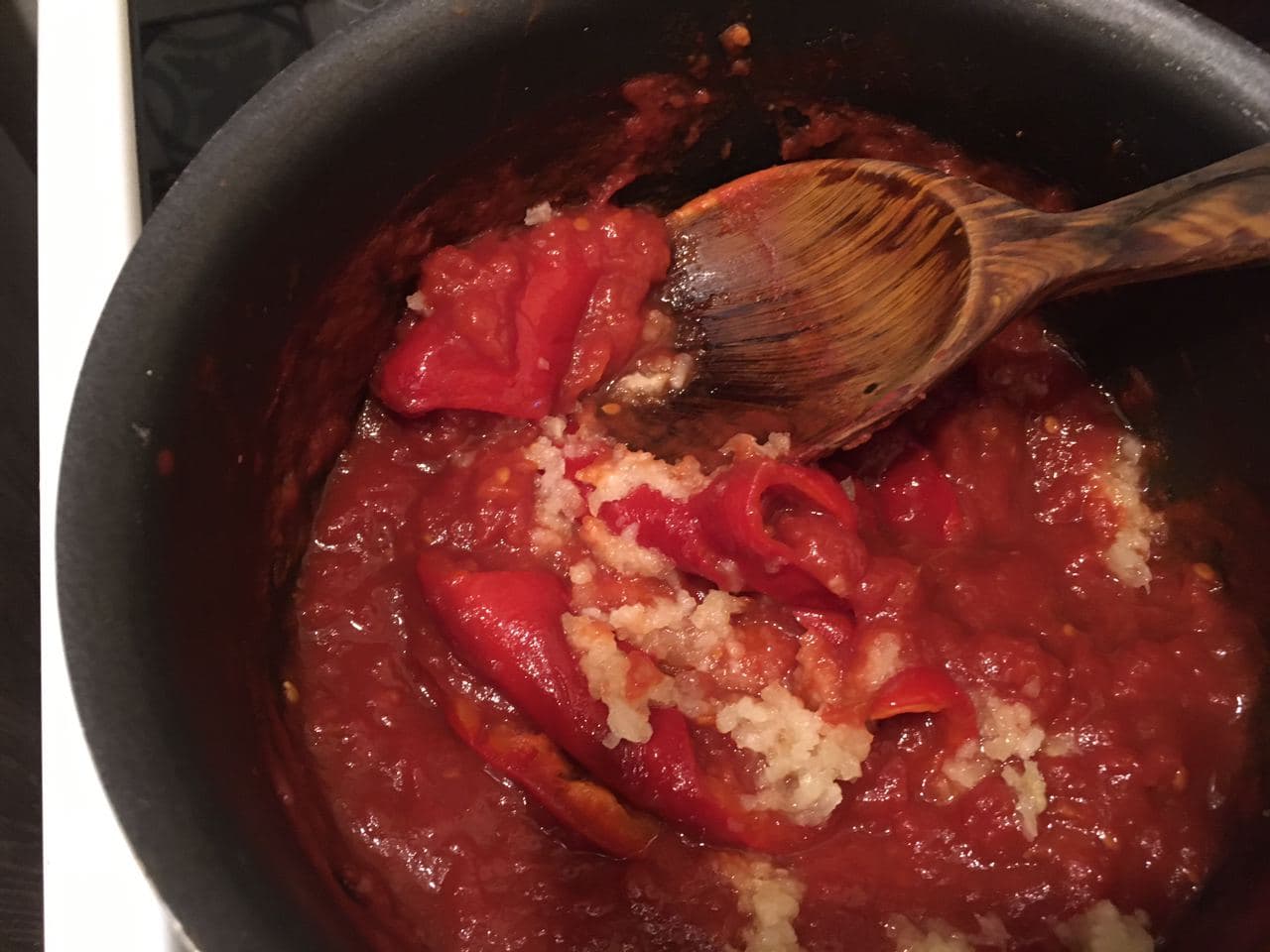
When the base is ready, you need to remove it from heat and grind it with a blender. The consistency is also a matter of personal preference, but the sauce itself is quite spicy, it is added half a teaspoon per plate and the large texture still does not work out as it would be in homemade eggplant caviar or other similar product. Therefore, I recommend making the base a homogeneous paste, without large inclusions. Although, the sauce in a transparent jar, with obvious pieces of sweet pepper, looks cool.
You can add finely chopped onions to the base and stew together with tomatoes, personally I did not do this, it seemed to me that the onion smell with this fruit pepper would not go well.
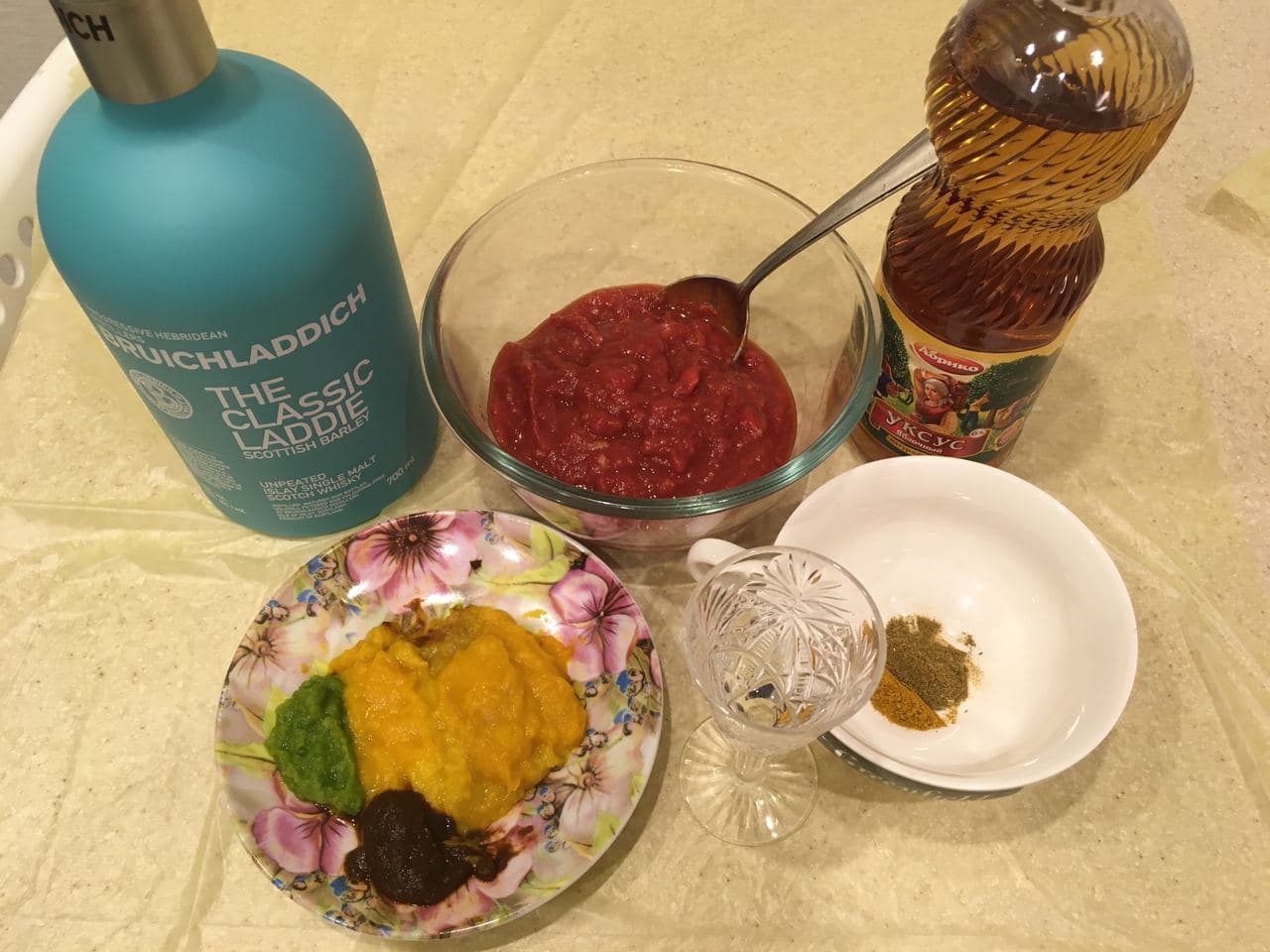 Almost everything is ready, now you need to mix hot pepper into the base.
Almost everything is ready, now you need to mix hot pepper into the base.
To do this, you need to prepare it a little, it is more convenient to do this in a small cup.
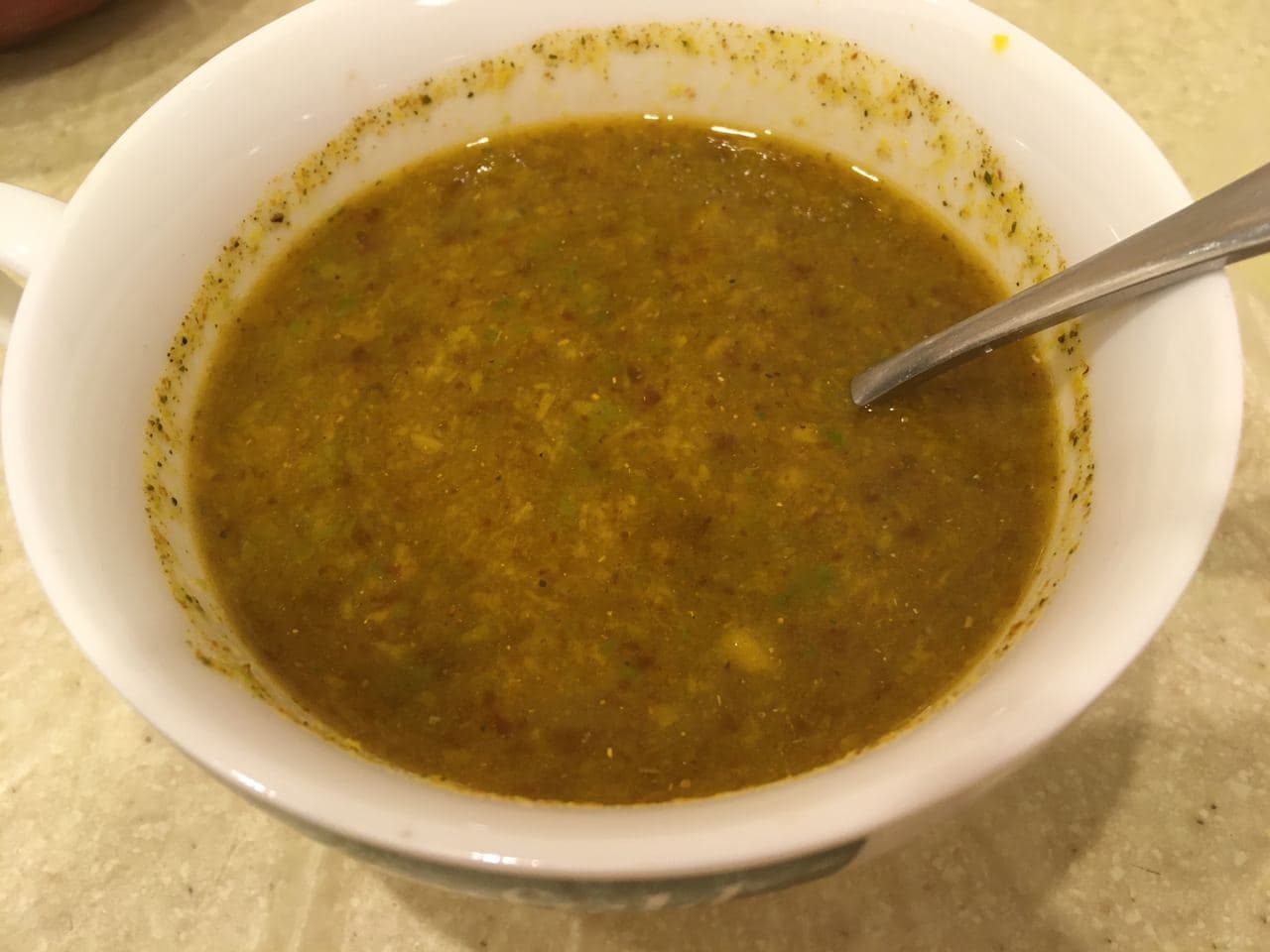
Pepper paste is diluted with vinegar and alcohol, half a teaspoon of herbal spices is added to it, everything is mixed and poured into a container with a base.
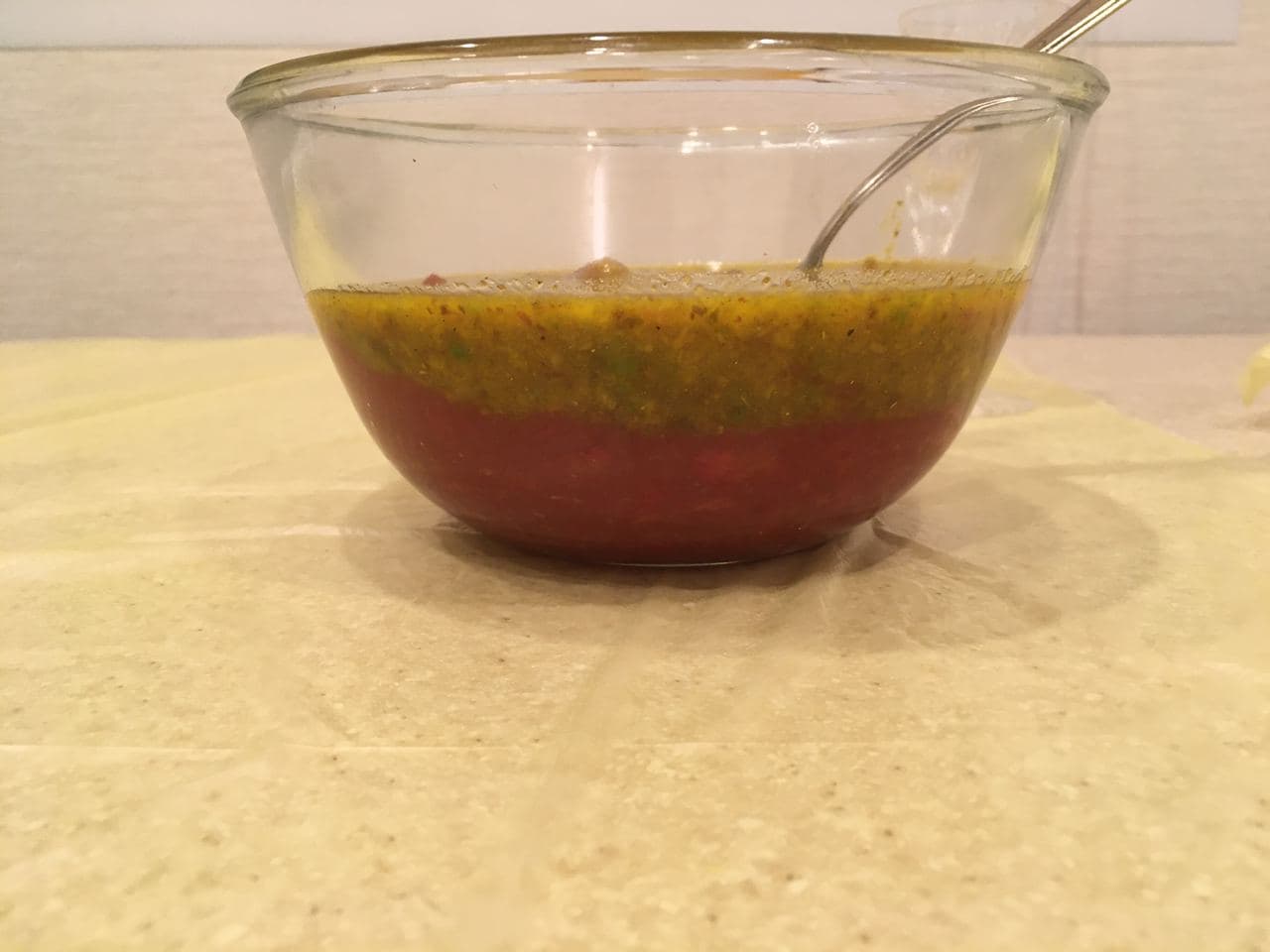
The sauce is almost ready, you just need to mix it sooo thoroughly. It changes the taste a little when it stands in the refrigerator, and all the juices are mixed and soak the base well.
I believe that the main thing in the sauce made from this particular pepper is its strong aroma, which is interestingly transformed after making the sauce according to the described recipe. It does not lose its bright fruity notes, but it becomes a little more vegetable, while still remaining strong.
The resulting sauce goes well with most dishes, side dishes, and snacks. It can be added to soup, or on the tip of a knife, stir in a spoonful of mustard and dip the chips there. It is practically not sweet, not at all sour and not salty, therefore it does not greatly affect the taste of the dish, but adds pungency and aroma to it.

Bon Appetit!
Special thanks to meklon for the peppers and Anton Makarony for the recipe and the detailed sauce guide!